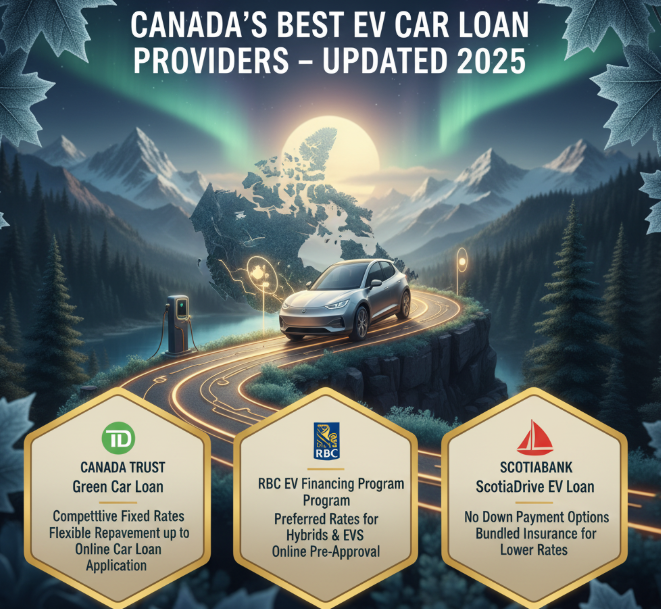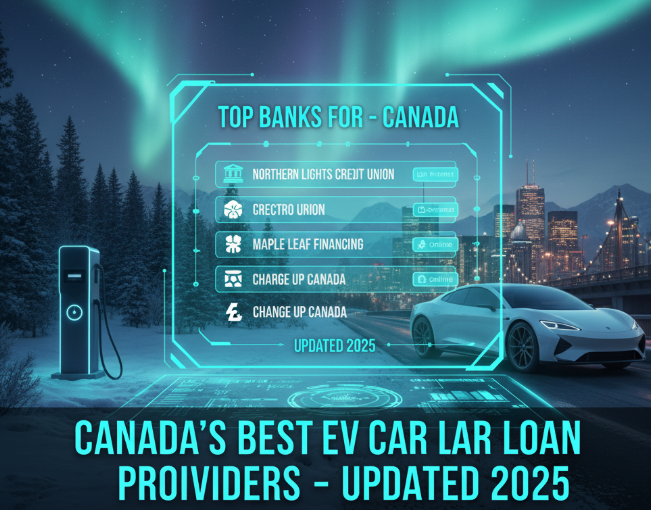Buying an electric vehicle (EV) is exciting — lower running costs, instant torque, and a smaller carbon footprint. But the price tag still matters. A smart loan can save you thousands over the life of the vehicle. This guide walks you through Canada’s best places to get an EV car loan in 2025, explains important loan features, and shows how to pick the right lender for your budget and goals.
I’ll keep the language simple and practical, and include comparison tables, lists, and examples so you can make a fast, confident choice.
Quick snapshot: What’s changed for EV buyers in 2025
- The federal iZEV rebate that used to offer up to $5,000 on eligible EVs paused in January 2025 after funds were fully committed. That pause affects many buyers and makes loan terms even more important when calculating total cost. Transport Canada
- Banks and credit unions continue to offer competitive auto loans for EVs. Some big banks now promote EV-specific offers or rewards for financing electric cars through them. RBC Royal Bank+1
- Automakers and dealers still run limited 0% or low-rate financing deals on certain EV models; these can beat bank rates but often require excellent credit and dealer negotiation. Electrek+1
Why loan choice matters more now than before
- With national rebates paused or reduced, the up-front price may be higher.
- Interest rates and term length determine how much you actually pay over time.
- Special offers—like 0% dealer financing—can save money but come with trade-offs (shorter terms, stricter eligibility).
- Some lenders provide EV perks (points, green incentives, flexible repayment) that add value beyond a simple rate. RBC Royal Bank+1
How to compare EV loan offers — quick checklist
- APR (annual percentage rate): Lower is better. Compare APRs across lenders.
- Term length (months): Longer terms lower monthly payments but increase total interest. Aim for balance.
- Down payment: Bigger down payment reduces the loan amount and monthly payments.
- Fees and penalties: Watch for origination fees, early repayment penalties, or admin charges.
- Pre-approval availability: Pre-approval gives bargaining power at dealerships.
- EV-specific perks: Cashback, reward points, or green discounts.
- Dealer vs bank vs credit union: Dealers may offer manufacturer promos; banks usually have steady rates; credit unions often have member-friendly terms.
Top EV loan providers in Canada (2025) — who to check first
Below is a shortlist of lenders and financing routes most EV buyers should compare in 2025. I include what they’re best for and one or two tips.
| Lender / Route | Best for | Notes |
|---|---|---|
| Big banks (RBC, TD, BMO, Scotiabank, CIBC) | Straightforward, reliable loans; nationwide access | Banks offer standard auto loans and sometimes EV-specific pages or promos (RBC has a dedicated EV loan resource). Compare pre-approval offers. RBC Royal Bank+2TD Bank+2 |
| Credit unions / Provincial banks | Slightly better rates for members; local service | Often competitive APRs and more flexible underwriting for local buyers. Worth checking if you’re a member. |
| Dealership / OEM financing | Short-term 0% or promotional financing | Manufacturer deals can offer 0% on select models (seasonal). Read the fine print: you may need top credit and shorter terms. Electrek+1 |
| Online loan marketplaces (LoansCanada, Finder, Ratehub) | Fast comparison across many lenders | One application can surface multiple quotes. Good starting point to see market APRs. finder.com+1 |
| Specialty green lenders / sustainable finance | Perks for low-carbon purchases | A small but growing field; check for reward points or carbon-aligned offers (some banks advertise green lending commitments). goldenbeltcoop.com |
Detailed look: What the big banks are offering in 2025
1) RBC (Royal Bank of Canada)
- RBC has a dedicated page and resources for EV buyers, and periodically runs limited-time promotions or rewards for financing EVs through certain products. Example: special Avion points promotion for eligible EV financing in 2025. Check RBC’s site for the latest offer windows. RBC Royal Bank
- Why consider RBC: strong dealer network, packaged lending options (e.g., secured car loan, lines of credit), and integrated digital banking tools.
2) TD Bank
- TD offers flexible amortization terms (in some cases up to 96 months on select vehicles), fixed or variable rates, and pre-approval. Useful if you want payment flexibility and the ability to negotiate at the dealership with a pre-approval in hand. TD Bank
3) BMO, CIBC, Scotiabank
- These institutions generally appear among the top auto lenders in Canada and frequently show competitive offers. They’re a good baseline for comparison when shopping for a new EV loan. Rate comparison sites list them among the top choices. Ratehub.ca
Dealer & manufacturer financing: when 0% beats everything
Automakers sometimes offer 0% APR or extremely low APR for specific models and limited periods. This can beat any bank or credit union rate — but:
- 0% deals often require near-perfect credit.
- They can be for shorter terms (36–48 months), so monthly payments may still be high.
- Don’t forget to compare total cost (selling price vs incentives vs financing). Sometimes dealer discounts plus a small APR are better than 0% at a higher sticker price. Electrek+1
Provincial rebates and incentives — check before you finalize
While the federal iZEV rebate paused in January 2025, provinces still run various incentives and charging supports. Always check:
- Quebec and British Columbia historically offered strong incentives and continue to have programs for chargers or used EVs.
- Ontario, Alberta, Nova Scotia and others may have local incentives or workplace charging supports.
- Use official provincial sites or trusted NGOs (like Plug’n Drive) to confirm current programs. RBC Royal Bank+1
Sample comparison table: what to expect on APR and terms (2025 ballpark)
Notes: Rates are approximate starting ranges and will vary by credit, down payment, dealer promos, and lender. Use this as a baseline — always get personalized quotes.
| Lender type | Typical APR range* | Typical terms | Perks / Notes |
|---|---|---|---|
| Banks (big five) | 4% – 8% | 36–84 months | Strong customer service, pre-approval |
| Credit unions | 3% – 7% | 36–96 months | Member-friendly, sometimes lower fees |
| Dealer / OEM (promo) | 0% – 4% (on offers) | 24–60 months | Best for short-term 0% deals if eligible |
| Online marketplace offers | 3.5% – 9% | 36–84 months | Quick comparison; one application to many lenders |
*These ranges are illustrative; your rate will depend on credit score, loan size, term, and current market conditions. For general market comparisons, see Ratehub and LoansCanada. Ratehub.ca+1
Step-by-step plan to get the best EV loan (7 steps)
- Check eligibility for rebates & provincial incentives. If your vehicle qualifies for any local rebates or charger incentives, factor them into your budget first. RBC Royal Bank
- Know your credit score. Better scores unlock the lowest APRs. Aim to improve any obvious errors before applying.
- Decide on timeline and monthly budget. Shorter loan = less interest but higher monthly payment.
- Get pre-approved from at least two lenders. Banks, credit union, and an online marketplace are good combos. Pre-approval helps at the dealer. finder.com
- Ask the dealer for OEM financing offers. Compare manufacturer promos (0% deals) to your pre-approved rate.
- Read the contract carefully. Watch for origination fees, early repayment penalties, and required insurance levels.
- Make a reasonable down payment. 10–20% down lowers your payments and reduces negative equity risk.

Real-world example: How financing affects total cost
Imagine you’re buying a $50,000 EV.
- Option A — Bank loan 5% APR, 72 months, $5,000 down
- Loan amount: $45,000 → Monthly ≈ $736 → Total interest ≈ $6,792
- Option B — 0% dealer financing 48 months, $5,000 down
- Loan amount: $45,000 → Monthly ≈ $937 → Total interest = $0
Which is better? If you can comfortably afford the higher monthly payment of Option B, 0% is cheaper overall. But if cash flow is tight, Option A’s lower monthly payment might be the only feasible choice.
Hidden factors EV buyers often miss
- Battery warranty & residual value: Some lenders offer flexible programs that account for battery concerns. A guaranteed residual (lease) vs purchase affects total cost.
- Insurance costs: EV insurance can be higher for some models — add this into monthly cost calculations.
- Charging costs & installation: Home charger installation is usually an extra upfront cost; some provincial programs help with this. Plug’n Drive Canada
Best lender picks by buyer type (2025)
- If you want lowest monthly payment: Check credit unions or banks with long-term amortization (but watch total interest).
- If you want lowest total cost: Manufacturer 0% promotions (if available and you qualify). Electrek
- If you want flexible refinance options later: Big banks with broad product suites (you can refinance into home equity or a line of credit later).
- If you want quick approvals and many options: Online loan marketplaces to compare dozens of offers at once. finder.com
Negotiation tips at the dealership
- Negotiate the price of the car first, not the monthly payment.
- Use your pre-approval as leverage. Dealers will often match or beat an outside rate to close the sale. finder.com
- Ask about incentives vs. financing trade-offs: sometimes an advertised cashback plus a modest APR is more valuable than 0% with a higher price.
- Read any fine-print about eligibility for promotional financing (minimum credit score, residency, proof of income).
Quick Q&A — fast answers to common buyer concerns
Q: Is it better to lease or buy an EV in 2025?
A: Leasing can lower monthly payments and make it easier to upgrade batteries/tech, but buying can be cheaper long-term if you plan to keep the car beyond the finance term.
Q: Are EV loans riskier than regular car loans?
A: Not really. Lenders look at the same credit factors. The only difference is depreciation patterns and battery concerns — some lenders may treat certain EV models differently.
Q: Will EV loan rates fall in the next year?
A: Rates track broader interest-rate trends. Watch Bank of Canada policy and promotions from automakers. If central rates fall, loan rates often follow.
Useful resources & comparison tools
- Ratehub.ca — national comparison of car loan offers and banks. Good for benchmarking. Ratehub.ca
- LoansCanada / Finder — marketplaces that show multiple lender options quickly. finder.com+1
- Transport Canada / iZEV updates — official status of federal rebates and eligible vehicles. (Important given the 2025 pause.) Transport Canada+1
- Plug’n Drive — independent NGO resource for EV incentives by province and charging info. Plug’n Drive Canada
Quick decision cheat-sheet (one-minute plan)
- Confirm rebate eligibility (federal + provincial). Transport Canada+1
- Check your credit score.
- Use an online marketplace + your bank for pre-approval. finder.com
- Ask dealer about any 0% promos for the model you want. Electrek
- Choose the loan that gives you the best balance of monthly payment and total cost.
Final takeaways
- With federal rebates paused in early 2025, the finance deal you choose matters more than ever. Get pre-approved and compare both bank and dealer offers. Transport Canada
- Big banks (RBC, TD, BMO, CIBC, Scotiabank) and credit unions remain the most reliable starting points — but don’t ignore temporary manufacturer financing if you qualify. RBC Royal Bank+2Ratehub.ca+2
- Use online comparison tools to shop multiple lenders with one application. Get pre-approval, negotiate the car price separately, and check provincial incentives for charger installation to lower your total ownership cost. finder.com+1

Leave a Reply